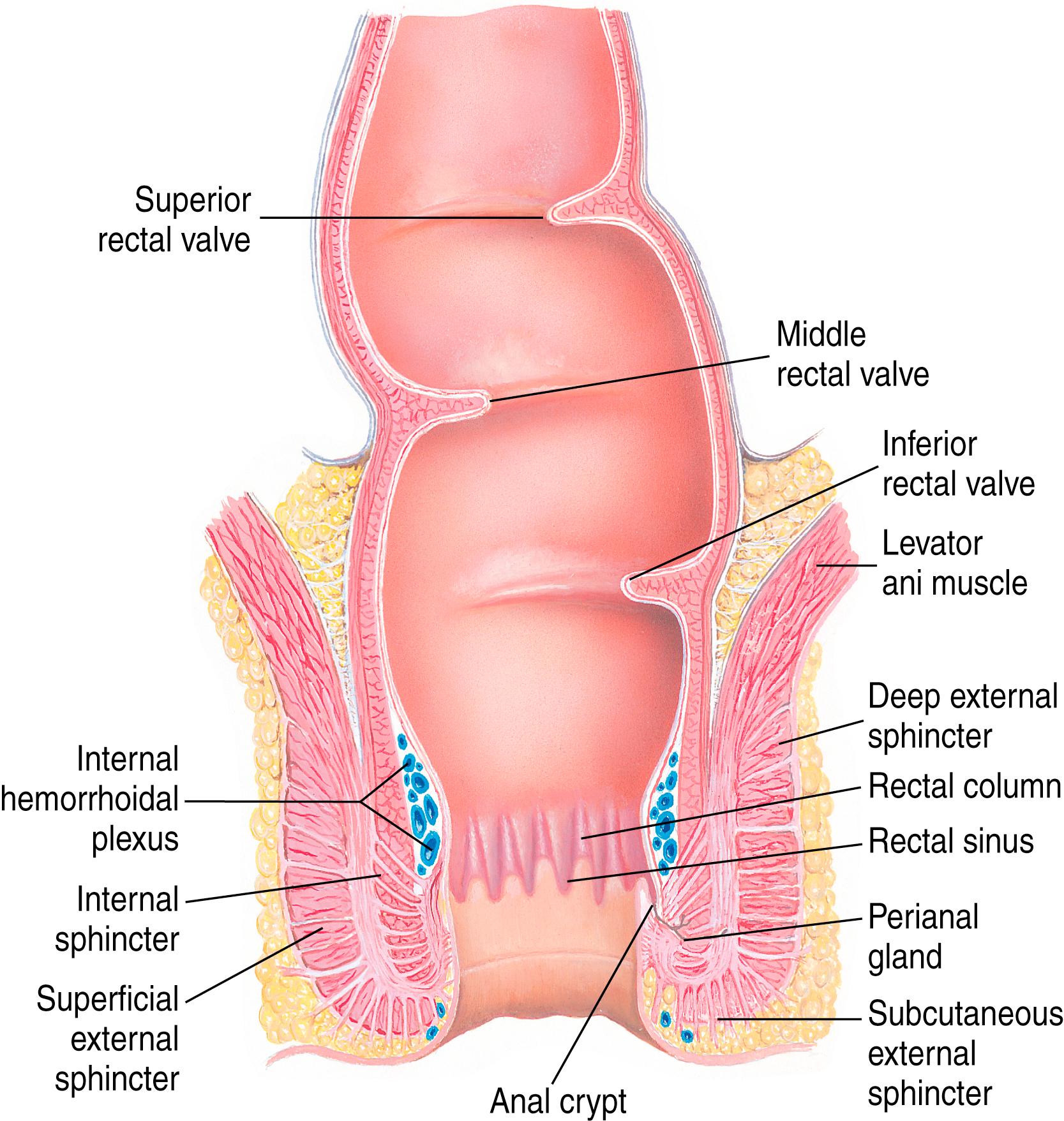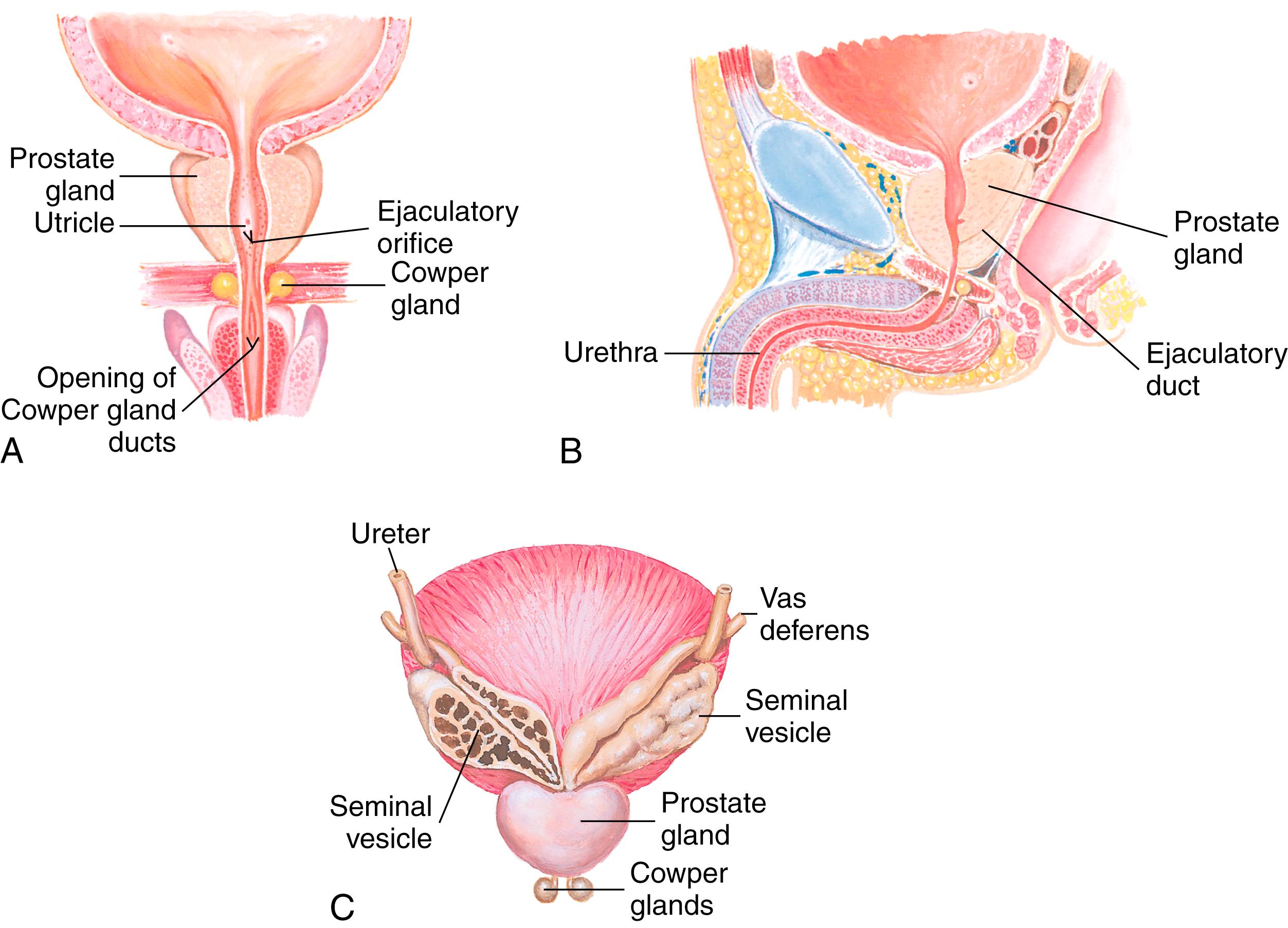Physical Address
304 North Cardinal St.
Dorchester Center, MA 02124
Examination of the anus and rectum may be performed as part of a routine health visit. In patients with a prostate, examination may include the prostate. Examination of these structures is also performed when the patient has a specific concern.
The rectum and anus form the terminal portions of the gastrointestinal (GI) tract ( Fig. 21.1 ). The anal canal is approximately 2.5 to 4 cm long and opens onto the perineum. The tissue visible at the external margin of the anus is moist, hairless mucosa. Juncture with the perianal skin is characterized by increased pigmentation and, in the adult, the presence of hair.

The anal canal is normally kept securely closed by concentric rings of muscle, the internal and external sphincters. The internal ring of smooth muscle is under involuntary autonomic control. The urge to defecate occurs when the rectum fills with feces, which causes reflexive stimulation that relaxes the internal sphincter. Defecation is controlled by the striated external sphincter, which is under voluntary control. The lower half of the canal is supplied with somatic sensory nerves, making it sensitive to painful stimuli, whereas the upper half is under autonomic control and is relatively insensitive. Therefore, conditions of the lower anus may cause pain, whereas those of the upper anus usually will not.
Internally, the anal canal is lined by columns of mucosal tissue (columns of Morgagni) that fuse to form the anorectal junction. The spaces between the columns are called crypts, into which anal glands empty. Inflammation of the crypts can result in fistula or fissure formation. Anastomosing veins cross the columns, forming a ring called the zona hemorrhoidalis. Internal hemorrhoids result from dilation of these veins. The lower segment of the anal canal contains a venous plexus that drains into the inferior rectal veins. Dilation of this plexus results in external hemorrhoids.
The rectum lies superior to the anus and is approximately 12 cm long. Its proximal end is continuous with the sigmoid colon. The distal end, called the anorectal junc
Inspect the sacrococcygeal and perianal area for:
Skin characteristics
Lesions
Pilonidal dimpling and/or tufts of hair
Inflammation
Excoriation
Inspect the anus for:
Skin characteristics and tags
Lesions, fissures, hemorrhoids, or polyps
Fistulae
Prolapse
Insert finger and assess sphincter tone
Palpate the muscular ring for smoothness and evenness of pressure against examining finger
Palpate the lateral, posterior, and anterior rectal walls for:
Nodules, masses, or polyps
Tenderness
Irregularities
In patients with a prostate, palpate the posterior surface of the prostate gland through the anterior rectal wall for:
Size
Contour
Consistency
Mobility
In patients with a uterus, palpate the cervix and uterus through the anterior rectal wall for:
Size
Shape
Position
Smoothness
Mobility
Have the patient bear down, and palpate deeper for tenderness and nodules
Withdraw the finger and examine fecal material for
Color
Consistency
Blood or pus
Occult blood by chemical test if indicated
Note: For transgender women who have had a vaginoplasty, the prostate is anterior to the vaginal wall. A digital neovaginal exam may be more effective.
tion, is visible on proctoscopic examination as a sawtooth-like edge, but it is not palpable. Above the anorectal junction, the rectum dilates and turns posteriorly into the hollow of the coccyx and sacrum, forming the rectal ampulla, which stores flatus and feces. The rectal wall contains three semilunar transverse folds (Houston valves), the lowest of which can be palpated by the examiner.
The prostate gland is located at the base of the bladder and surrounds the urethra. It is composed of muscular and glandular tissue and is approximately 4 × 3 × 2 cm. The posterior surface of the prostate gland is in close contact with the anterior rectal wall and is accessible by digital examination. It is convex and divided by a shallow median sulcus into right and left lateral lobes. A third or median lobe, not palpable on examination, is composed of glandular tissue and lies between the ejaculatory duct and the urethra. It contains active secretory alveoli that contribute to ejaculatory fluid. The seminal vesicles extend outward from the prostate ( Fig. 21.2 ).

The vagina lies in contact with the anterior rectal wall of the rectum and is separated from it by the rectovaginal septum. See Chapter 19 for a more detailed discussion.
At 7 weeks of gestation, a portion of the caudal hindgut is divided by an anorectal septum into a urogenital sinus and a rectum. The urogenital sinus is covered by a membrane that develops into the anal opening by 8 weeks of gestation. Most anorectal malformations result from abnormalities in this partitioning process.
The first meconium stool is ordinarily passed within the first 24 after birth and indicates anal patency. It is common for newborns, especially those who are breast-fed, to have a stool after each feeding (the gastrocolic reflex). Both the internal and external sphincters are under involuntary reflexive control as myelination of the spinal cord is incomplete.
By the end of the first year, the infant may have one or two bowel movements daily. Children are developmentally ready to begin toilet training between 2 and 4 years of age. Girls typically acquire bladder control before boys; bowel control typically is achieved before bladder control.
The prostate is small, inactive, and not palpable on rectal examination. The prostate remains undeveloped until puberty, at which time androgenic influences prompt its growth and maturation. The initially minimal glandular component develops active secretory alveoli, and the prostate becomes functional.
During pregnancy, pressure increases in the veins below the enlarged uterus. Dietary habits and hormonal changes that decrease gastrointestinal tract tone and motility produce constipation. These factors predispose pregnant individuals to the development of hemorrhoids. Labor, which results in pressure on the pelvic floor by the presenting part of the fetus and expulsive efforts of the pregnant patient, may also aggravate the condition, causing protrusion and inflammation of hemorrhoids.
Degeneration of afferent neurons in the rectal wall interferes with the process of relaxation of the internal sphincter in response to distention of the rectum. As a result, the older adult may have a higher pressure threshold for the sensation of rectal distention with consequent retention of stool. Conversely, as the autonomically controlled internal sphincter loses tone, the external sphincter, by itself, cannot control the bowels, and the older adult may experience fecal incontinence.
The fibromuscular structures of the prostate gland atrophy, with loss of function of the secretory alveoli; however, the atrophy associated with aging is often obscured by benign hyperplasia of the glandular tissue. The muscular component of the prostate is progressively replaced by collagen.
For each of the symptoms or conditions discussed in this section, targeted topics to include in the history of the present illness are listed. Responses to questions about these topics provide clues for focusing the physical examination and the development of an appropriate diagnostic evaluation. Questions regarding medication use (prescription and over-the-counter preparations) as well as complementary and alternative therapies are relevant for each.
Character: number, frequency, consistency of stools; presence of mucus or blood; color (dark, bright red, black, light, or clay-colored); odor
Onset and duration: sudden or gradual, relation to dietary change, relation to stressful events
Accompanying symptoms: incontinence, flatus, pain, fever, nausea, vomiting, cramping, abdominal distention
Medications: iron, laxatives, stool softeners
Relation to body position and defecation
Straining at stool
Presence of mucus or blood
Interference with activities of daily living or sleep
Medications: hemorrhoid preparations
Color: bright or dark red, black
Relation to defecation
Amount: spotting on toilet paper versus active bleeding
Accompanying changes in stool: color, frequency, consistency, shape, odor, presence of mucus
Associated symptoms: incontinence, flatus, rectal pain, abdominal pain or cramping, abdominal distention, weight loss
Medications: iron, fiber additives
History of enlarged prostate or prostatitis
Symptoms: hesitancy, urgency, nocturia, dysuria, change in force or caliber of stream, dribbling, urethral discharge
Medications: antihistamines, anticholinergics, tricyclic antidepressants, 5-alpha-reductase inhibitors, hormone therapy
Gender identity: e.g., female, male, non-binary, transgender woman, transgender man; gender assigned at birth
Organ inventory: prostate gland; penis (natal or surgically constructed), scrotum and testicles, (natal or surgically constructed), prostate gland, clitoris (natal or surgically constructed) vagina (natal or surgically constructed), cervix, uterus, fallopian tubes, ovaries
Hemorrhoids
Spinal cord injury
Bowel habits and characteristics: timing, frequency, number, consistency, shape, color, odor
Males, transgender women, and non-binary individuals assigned male at birth: prostatic hypertrophy or carcinoma
Females, transgender men, and non-binary individuals assigned female at birth: episiotomy or fourth-degree laceration during delivery
Colorectal cancer or related cancers: breast, ovarian, endometrial
Anal, rectal, prostate surgeries
Rectal polyps
Colon cancer or familial cancer syndromes (see risk Factors box, Chapter 18 )
Prostate cancer (see Risk Factors box)
Travel history: areas with high incidence of parasitic infestation, including zones in the United States
Diet: inclusion of fiber foods (cereals, breads, nuts, fruits, vegetables) and concentrated high-fiber foods; amount of animal fat
Risk factors for colorectal, prostate, or anal cancer (see Risk Factors Box in Chapter 18 )
Sexual practices at risk for anal HPV infection (see Patient Safety, “Sexually Transmitted Infections” and Box 21.1 )
The Centers for Disease Control and Prevention (CDC) has identified populations who are at risk for sexually transmitted infections based on sexual practices or, in the case of fetuses, are at risk for debilitating effects of intrauterine or perinatally transmitted infections. Adolescents, persons in correctional facilities, men who have sex with men, women who have sex with women, and transgender men and women may engage in practices that expose them to a variety of sexually transmitted Diseases. The CDC has specific screening and prevention recommendations for each group which are available at http://www.cdc.gov/std/tg2015/specialpops.htm .
Vaccination status for the human papilloma virus (HPV)
Use of alcohol
Age: Older than 50 years
Race/ethnicity: more common in African Americans and in Caribbean patients of African ancestry; less common in Asian American and Hispanic/Latinos than in non-Hispanic whites
Geography: common in North America and northwestern Europe, Australia, and on Caribbean islands; less common in Asia, Africa, Central America, and South America
Family history of prostate cancer: twice the risk with one first-degree relative; risk increases with more than one first-degree relative. The risk is higher for those who have a brother with prostate cancer than for those who have a father with it.
Inherited cancer syndromes: BRCA1, BRCA2 mutations; hereditary nonpolyposis colorectal cancer (Lynch syndrome)
Gonadectomy in transgender women may reduce but does not eliminate the risk of prostate cancer
Infection with high-risk type HPV
HPV-related conditions: anal warts, cervical cancer
Multiple sexual partners
Receptive anal intercourse
Cigarette smoking
Immunosuppression: HIV infection
Gender/ethnicity: more common in white females and black males
Newborns: characteristics of stool
Bowel movements accompanied by crying, straining, bleeding
Feeding habits: types of foods, milk (formula or breast for infants), appetite
Age at which bowel control and toilet training were achieved
Encopresis (involuntary “fecal soiling” in children who have usually already been toilet-trained)
Associated symptoms: episodes of diarrhea or constipation; tenderness when cleaning after a stool; perianal irritations; weight loss; abdominal pain, nausea, vomiting
Congenital anomaly: imperforate anus, myelomeningocele, aganglionic megacolon
Weeks of gestation and estimated date of delivery
Exercise
Fluid intake and dietary habits
Medications: prenatal vitamins, iron, fiber supplements
Use of complementary or alternative therapies
Changes in bowel habits or character: frequency, number, color, consistency, shape, odor
Associated symptoms: weight loss, rectal or abdominal pain, incontinence, flatus, episodes of constipation or diarrhea, abdominal distention, rectal bleeding
Dietary changes: fluid intake, intolerance for certain foods, inclusion of high-fiber foods, regularity of eating habits, appetite
History of enlarged prostate, urinary symptoms (hesitancy, urgency, nocturia, dysuria, force and caliber of urinary stream, dribbling)
Become a Clinical Tree membership for Full access and enjoy Unlimited articles
If you are a member. Log in here